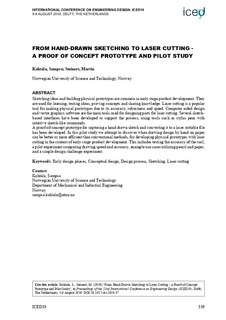| dc.contributor.author | Kohtala, Sampsa | |
| dc.contributor.author | Steinert, Martin | |
| dc.date.accessioned | 2019-11-25T09:55:46Z | |
| dc.date.available | 2019-11-25T09:55:46Z | |
| dc.date.created | 2019-10-03T15:01:20Z | |
| dc.date.issued | 2019 | |
| dc.identifier.citation | Proceedings of the International Conference on Engineering Design. 2019, 1 339-348. | nb_NO |
| dc.identifier.issn | 2220-4334 | |
| dc.identifier.uri | http://hdl.handle.net/11250/2630190 | |
| dc.description.abstract | Sketching ideas and building physical prototypes are common in early stage product development. They are used for learning, testing ideas, proving concepts and sharing knowledge. Laser cutting is a popular tool for making physical prototypes due to its accuracy, robustness and speed. Computer aided design and vector graphics software are the main tools used for designing parts for laser cutting. Several sketch- based interfaces have been developed to support the process, using tools such as stylus pens with intuitive sketch-like commands.
A proof-of-concept prototype for capturing a hand drawn sketch and converting it to a laser cuttable file has been developed. In this pilot study we attempt to discover when drawing design by hand on paper can be better or more efficient than conventional methods, for developing physical prototypes with laser cutting in the context of early stage product development. This includes testing the accuracy of the tool, a pilot experiment comparing drawing speed and accuracy, example use cases utilizing pencil and paper, and a simple design challenge experiment. | nb_NO |
| dc.language.iso | eng | nb_NO |
| dc.publisher | Cambridge University Press | nb_NO |
| dc.rights | Attribution-NonCommercial-NoDerivatives 4.0 Internasjonal | * |
| dc.rights.uri | http://creativecommons.org/licenses/by-nc-nd/4.0/deed.no | * |
| dc.title | From Hand-Drawn Sketching to Laser Cutting - A Proof of Concept Prototype and Pilot Study | nb_NO |
| dc.type | Journal article | nb_NO |
| dc.type | Peer reviewed | nb_NO |
| dc.description.version | publishedVersion | nb_NO |
| dc.source.pagenumber | 339-348 | nb_NO |
| dc.source.volume | 1 | nb_NO |
| dc.source.journal | Proceedings of the International Conference on Engineering Design | nb_NO |
| dc.identifier.doi | 10.1017/dsi.2019.37 | |
| dc.identifier.cristin | 1733612 | |
| dc.description.localcode | © The Author(s) 2019 This is an Open Access article, distributed under the terms of the Creative Commons Attribution-NonCommercial-NoDerivatives licence (http://creativecommons.org/licenses/by-nc-nd/4.0/), which permits non-commercial re-use, distribution, and reproduction in any medium, provided the original work is unaltered and is properly cited. The written permission of Cambridge University Press must be obtained for commercial re-use or in order to create a derivative work. | nb_NO |
| cristin.unitcode | 194,64,92,0 | |
| cristin.unitname | Institutt for maskinteknikk og produksjon | |
| cristin.ispublished | true | |
| cristin.fulltext | original | |
| cristin.qualitycode | 1 | |

